Foraging wild herbs for your tea blends brings unmatched flavors and health benefits right to your cup. It's not only a fun outdoor activity but also a way to connect with local ecosystems. By gathering herbs like dandelion, mint, and wild chamomile, you enhance your brews with unique profiles while tapping into their antioxidants and vitamins. Plus, foraging encourages physical activity and mindfulness, boosting your mood. You'll enjoy the richness that store-bought teas can't match. If you're curious about the best herbs to forage and how to prepare them, you'll find plenty of insights ahead.
Benefits of Foraging
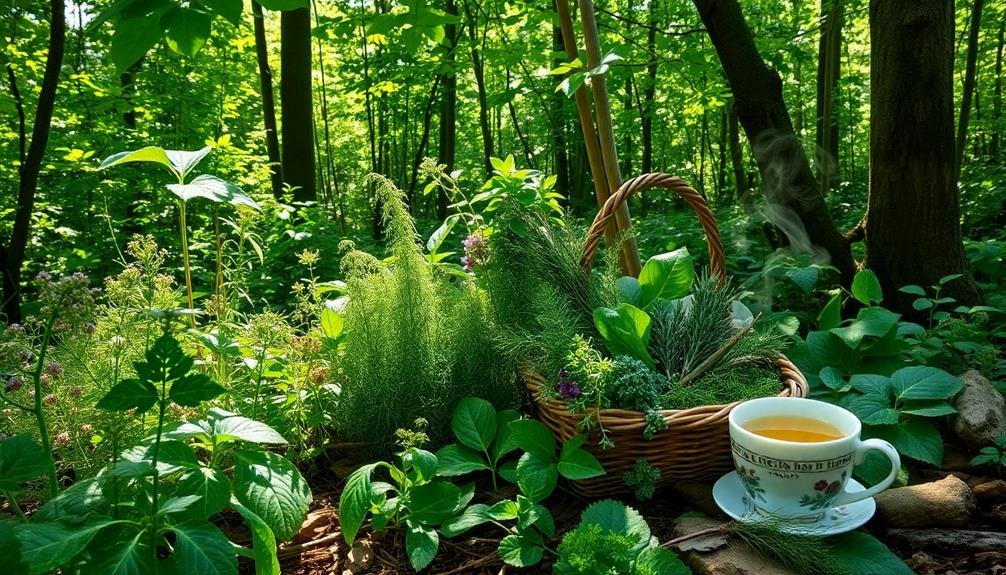
Foraging for wild herbs not only connects you with nature but also offers a host of benefits. When you step outside to gather herbs, you engage in a rewarding experience that enhances your well-being. The fresh air and natural surroundings can reduce stress, boost your mood, and improve your overall mental health.
You'll find that spending time in nature fosters mindfulness and encourages you to appreciate the world around you.
Additionally, foraging allows you to discover unique flavors and aromas that store-bought herbs simply can't match. By hand-picking your ingredients, you guarantee that they're fresh and free from additives, providing superior taste in your tea blends. This practice also encourages physical activity, as you'll be walking, bending, and stretching to gather your herbs.
Moreover, foraging can deepen your connection to the local environment. By learning about the plants in your area, you gain insight into their ecosystems and seasonal changes. This knowledge empowers you to make informed choices about sustainability and conservation.
Identifying Safe Edible Herbs
When foraging for wild herbs, it's essential to know which ones are safe to eat.
You'll want to familiarize yourself with common edible herbs and learn key identification techniques to avoid any toxic look-alikes.
Plus, keeping safety precautions in mind will guarantee your foraging experience is both enjoyable and risk-free.
Common Edible Wild Herbs
Exploring the world of wild herbs opens up a treasure trove of flavors and health benefits, but identifying safe edible varieties is crucial. Among the most common edible wild herbs, you'll find dandelion, chickweed, and nettle.
Dandelion leaves are packed with vitamins and can add a slightly bitter yet invigorating taste to your tea blends. Chickweed, with its mild flavor, makes a great addition to salads and infusions alike.
Nettle is another powerhouse; just be sure to handle it carefully, as its stinging hairs can be irritating. Once cooked or dried, however, nettle becomes a nutritious ingredient that enhances both flavor and health benefits.
Then there's plantain, often overlooked but highly versatile; its leaves can be used in teas and salads, offering a subtle earthiness.
You might also encounter wild garlic, which has a distinct aroma and can elevate any herbal blend.
As you explore these common edible wild herbs, remember to verify you're foraging from clean areas, away from pollutants. By incorporating these herbs into your teas, you'll not only enjoy their unique flavors but also reap their numerous health benefits.
Key Identification Techniques
Identifying safe edible herbs is a vital skill for anyone interested in foraging. To enjoy your wild herbal tea blends confidently, you need to develop a keen eye for distinguishing edible plants from toxic lookalikes.
Here are three key identification techniques to help you on your foraging journey:
- Know the Plant Characteristics: Familiarize yourself with specific traits such as leaf shape, flower color, and growth habits. Use field guides or apps to compare your finds with known edible herbs.
- Smell and Taste: Many edible herbs have distinct aromas and flavors. Gently crush a leaf to release its scent, and if you're confident, taste a small piece. Just make sure to only taste herbs you've positively identified.
- Season and Habitat: Understand the seasons in which your target herbs grow and where they tend to thrive. Knowing their preferred environments—like wetlands, woodlands, or meadows—can help you locate them more easily.
Safety Precautions When Foraging
Foraging for wild herbs can be a rewarding experience, but ensuring your safety is paramount. You need to confidently identify safe edible herbs, as some plants can be toxic. Always double-check your identification with reliable resources, like field guides or apps, and consider joining local foraging groups for guidance.
Here's a quick reference table to help you distinguish between safe and unsafe herbs:
| Safe Edible Herbs | Toxic Look-Alikes |
|---|---|
| Dandelion | Poison Hemlock |
| Chickweed | Spurge |
| Lamb's Quarters | Nightshade |
| Plantain | Foxglove |
When you're out foraging, remember to take note of the environment. Avoid picking near roadsides or polluted areas, as contaminants can affect the herbs. Start with small amounts to test for allergic reactions. Finally, familiarize yourself with local regulations regarding foraging; some areas may have restrictions.
Popular Wild Herbs for Tea
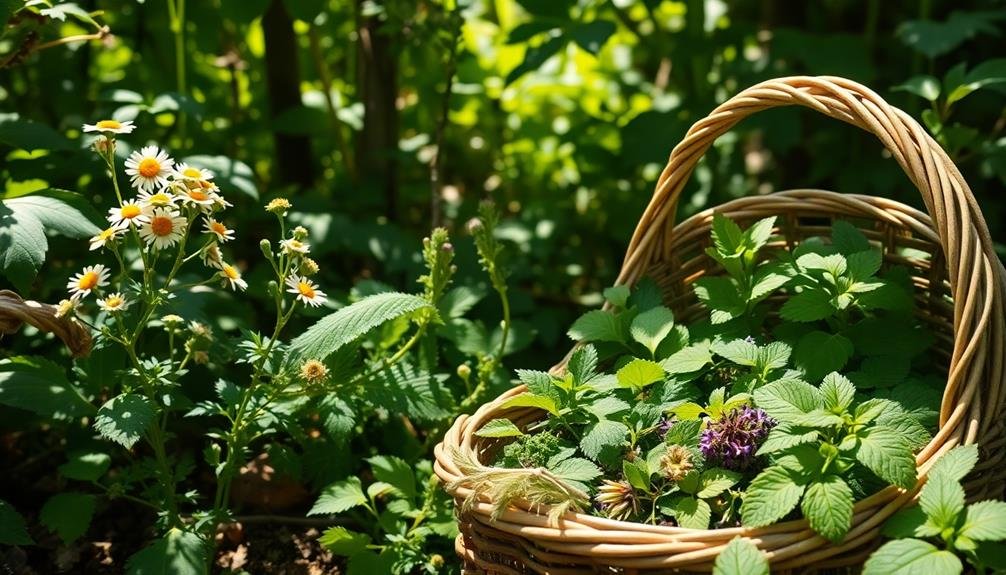
When you're foraging for wild herbs to brew tea, you'll find a variety of options that offer both unique flavors and nutritional benefits.
Each herb brings its own distinct profile, from the invigorating notes of mint to the earthy tones of nettle.
Understanding these characteristics can help you create blends that not only taste great but also boost your health.
Nutritional Benefits of Herbs
Herbs are more than just flavorful additions to your tea; they're packed with nutritional benefits that can enhance your overall well-being.
When you forage for wild herbs, you're not only connecting with nature but also tapping into a treasure trove of health-boosting properties.
Here are three key nutritional benefits of wild herbs:
- Antioxidants: Many wild herbs contain high levels of antioxidants, which help combat oxidative stress in your body. This can lead to improved immune function and reduced inflammation.
- Vitamins and Minerals: Wild herbs are often rich in essential vitamins and minerals. For instance, nettle is a great source of vitamin C and iron, while dandelion provides a healthy dose of vitamin A and potassium.
- Digestive Support: Certain herbs, like peppermint and chamomile, are known for their digestive properties. They can soothe an upset stomach and help improve digestion, making your tea not only delicious but also beneficial.
Flavor Profiles and Varieties
Often, you'll discover a delightful array of wild herbs that lend unique flavor profiles to your tea blends. Each herb carries its own character, adding depth and complexity to your brews.
For instance, lemon balm offers a rejuvenating, citrusy note that's perfect for uplifting your spirits. If you want something more earthy, consider foraging for stinging nettle, which provides a rich, green flavor that pairs wonderfully with other herbs.
You might also enjoy the fragrant aroma of wild chamomile, with its sweet, apple-like taste that soothes and calms.
Another great option is mint, particularly wild spearmint, which adds a cooling, invigorating kick to your tea.
Don't overlook the unique spiciness of wild ginger, which can brighten your blends with warmth and zest. Each of these herbs can stand alone or complement others in your mix, enhancing the overall experience.
By experimenting with different combinations, you'll find the perfect balance of flavors that excite your palate and nourish your body.
Sustainable Foraging Practices
Sustainable foraging practices guarantee that our natural resources remain abundant for future generations.
By following these principles, you can enjoy the benefits of wild herbs while safeguarding their preservation.
Here are three key practices to adopt:
- Know the Regulations: Before you head out, familiarize yourself with local laws regarding foraging. Many areas have restrictions to protect certain species. Always respect these rules to maintain ecological balance.
- Harvest Responsibly: When foraging, only take a small percentage of each plant you find. A good rule of thumb is to leave at least 70% of the plant intact. This practice ensures that the plants can continue to thrive and reproduce, maintaining a healthy ecosystem.
- Be Mindful of Biodiversity: Focus on foraging a variety of herbs rather than over-harvesting a single species. This approach helps to preserve local biodiversity and supports the overall health of your foraging area.
Seasonal Considerations for Foraging

Timing your foraging trips can make all the difference in your herbal tea blends. Each season brings a unique array of wild herbs, and knowing when to gather them can enhance both flavor and health benefits.
Spring is ideal for tender greens like nettle and dandelion, which are packed with nutrients. As the days warm up, you'll find vibrant flowers like chamomile and calendula ready for harvest in early summer.
In late summer, consider foraging for herbs such as mint and lemon balm, which thrive in the warmth. Autumn is the perfect time for gathering roots like burdock and chicory, which add depth to your blends.
Pay attention to local frost dates, as they can affect when certain herbs are at their peak.
Don't forget that foraging conditions can vary by region, so it's essential to know your local climate. Keep a calendar to track the best times for your favorite herbs, and be flexible—nature can be unpredictable.
Preparing Herbs for Tea Blends
Preparing your foraged herbs for tea blends is an essential step that can elevate your brewing experience.
Whether you've gathered mint, chamomile, or nettle, the way you prepare these herbs can impact the flavor, aroma, and overall enjoyment of your tea.
Here's a simple guide to get you started:
1. Clean Your Herbs: Rinse your foraged herbs gently under cold water to remove any dirt or insects.
Pat them dry with a clean towel to keep them fresh.
2. Chop or Tear: Depending on the type of herb, you might want to chop or tear the leaves.
Smaller pieces release their flavors more readily during brewing, so don't hesitate to get a bit rough with them.
3. Drying (if needed): If you're not using the herbs immediately, consider drying them.
Lay them out in a single layer on a clean surface, away from direct sunlight.
Once fully dried, store them in an airtight container to preserve their essence until you're ready to brew.
Enhancing Flavor Profiles
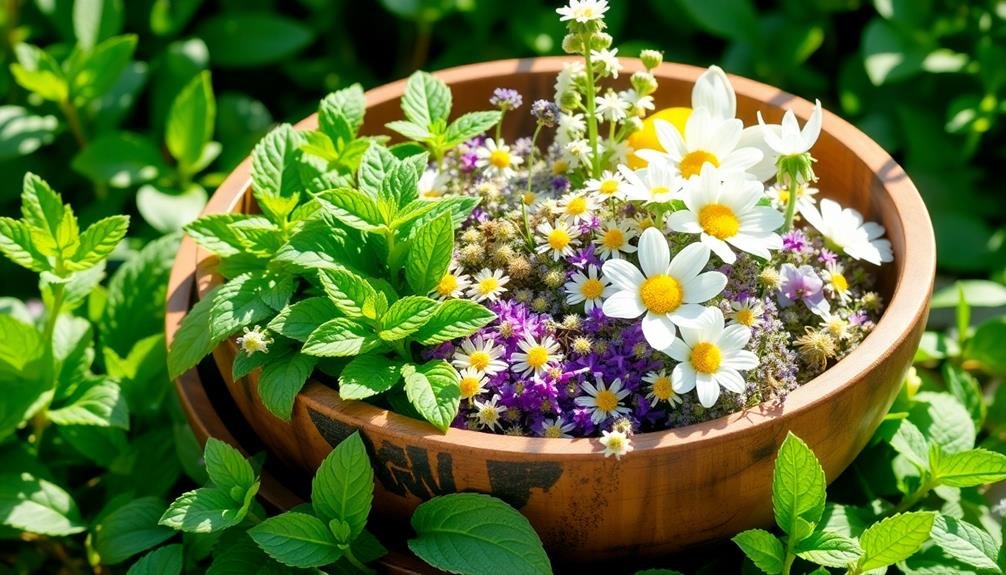
Enhancing your tea blends' flavor profiles can transform a simple brew into a delightful experience. Foraging wild herbs allows you to tap into nature's bounty, bringing unique flavors that store-bought options often lack. By experimenting with various herbs, you can create a symphony of tastes that excite your palate.
Here's a quick guide to common wild herbs and their flavor contributions:
| Herb | Flavor Profile | Best Pairings |
|---|---|---|
| Mint | Cool, invigorating | Green tea, citrus fruits |
| Lemon Balm | Mildly lemony | Chamomile, honey |
| Nettle | Earthy, grassy | Ginger, hibiscus |
| Dandelion | Bitter, nutty | Black tea, rooibos |
Health Benefits of Wild Herbs
Foraging wild herbs isn't just about crafting flavorful tea blends; it also offers a wealth of health benefits. When you incorporate these herbs into your teas, you're not only adding taste but also boosting your well-being.
Here are three key health benefits you can enjoy:
- Rich in Antioxidants: Many wild herbs are packed with antioxidants, which help combat oxidative stress in your body. This can support your immune system and promote overall health.
- Digestive Support: Certain wild herbs, like peppermint and dandelion, can aid digestion. They can help soothe your stomach, reduce bloating, and promote regularity, making your tea a comforting remedy.
- Anti-Inflammatory Properties: Herbs like nettle and burdock are known for their anti-inflammatory effects. Including these in your blends may help reduce inflammation, potentially easing conditions like arthritis or other chronic issues.
Frequently Asked Questions
What Equipment Do I Need for Foraging Wild Herbs?
You'll need a sturdy basket or bag to collect herbs, scissors or shears for cutting, gloves to protect your hands, and a field guide to help identify safe plants. A water bottle's handy too!
How Can I Ensure I'm Foraging Legally?
To guarantee you're foraging legally, research local laws and regulations regarding wild harvesting. Always seek permission if foraging on private land, and avoid protected areas or endangered plants to respect nature and conservation efforts.
Are There Any Risks Associated With Foraging?
Yes, there are risks when foraging. You might misidentify plants, which can lead to poisoning or allergic reactions. Additionally, harvesting from protected areas can result in legal consequences. Always research and be cautious before foraging.
Can I Forage in Urban Areas?
Yes, you can forage in urban areas! Just be mindful of pollution, pesticides, and local regulations. Always verify you correctly identify plants and avoid spots near busy roads or industrial sites to stay safe.
How Do I Store Foraged Herbs Properly?
To store foraged herbs properly, you should rinse and dry them thoroughly. Then, place them in airtight containers or freezer bags, labeling them with the date. Keep them in a cool, dark place or freeze for longer freshness.
In Summary
Foraging wild herbs for your tea blends not only connects you to nature but also enriches your tea experience. You'll discover unique flavors, boost your health with their natural benefits, and embrace sustainable practices. By learning to identify safe herbs and preparing them thoughtfully, you can create delightful blends that reflect the seasons. So grab your basket, explore your surroundings, and enjoy the rewarding journey of crafting your own herbal teas. Happy foraging!

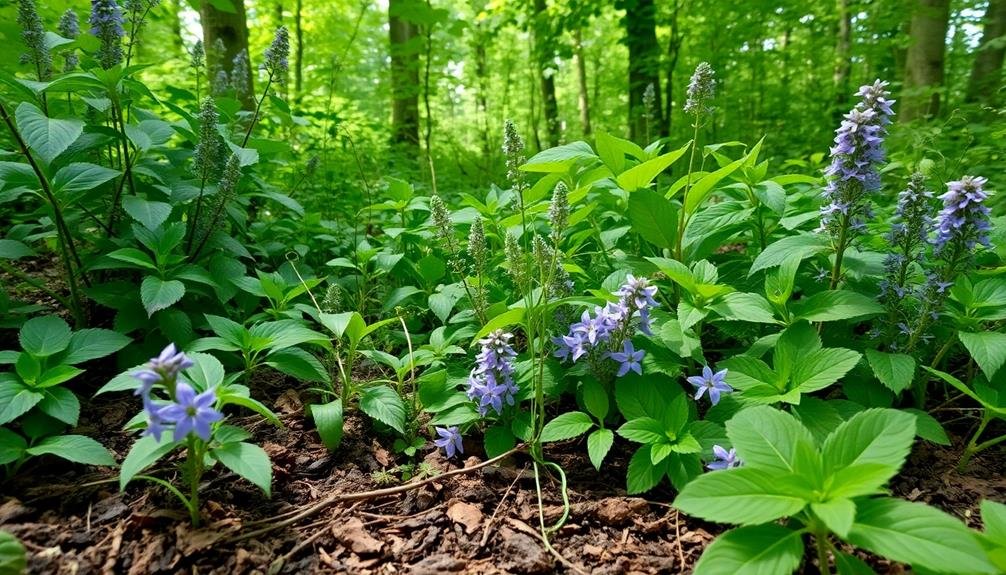
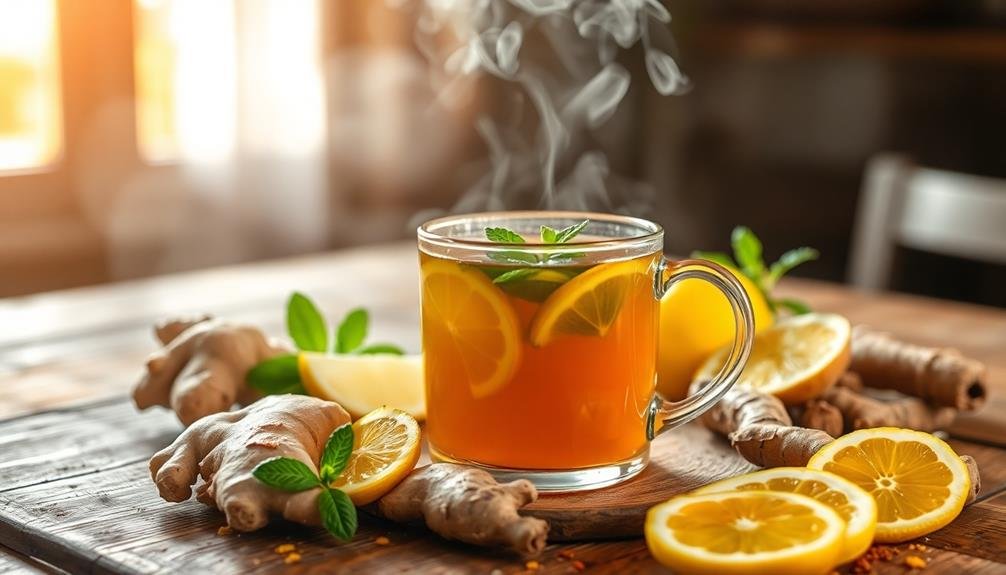
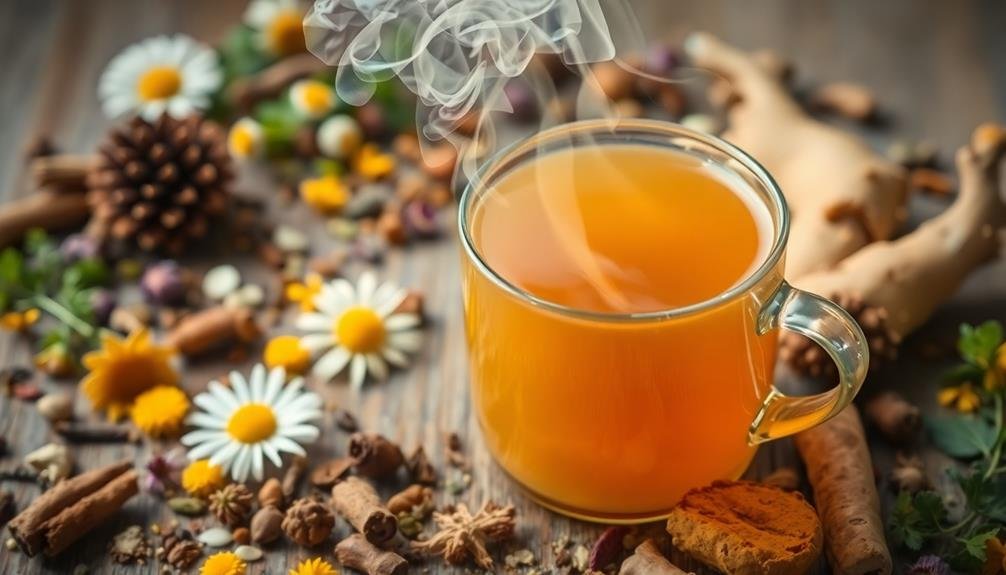
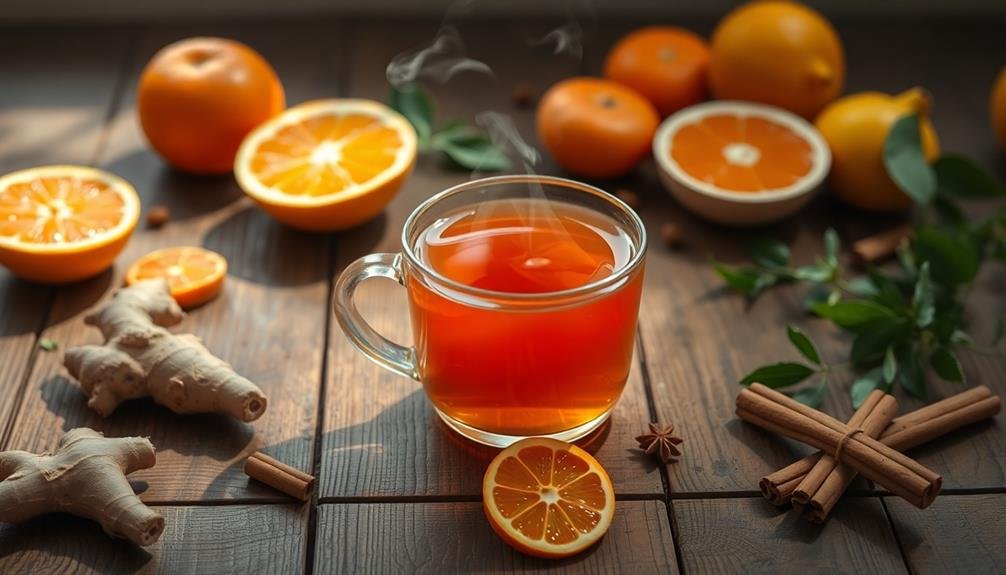
Leave a Reply